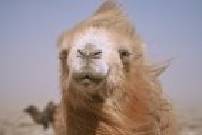|
|
||||
|
|
by Donald Levit  Liquid-eyed, huggy-cuddly, tail-wagging and thus seldom aquatic or airborne, family-fare animals (with the exception of orcas Namu and Willie and dolphin Flipper) are canine, equine, feline, less often anthropoid, porcine, elephantine or ursine. Movies anthropomorphize their ostensible four-legged subjects and reveal more about their human protagonists, usually youngsters guided by a salty old-timer. Even Annaud's The Bear touches hunter-trapper violence and grizzly sex while building to a pious ecological finale. Seabiscuit is fun but pretty Hollywood motivational in its parallels of down-but-not-out nation, horse, jockey, trainer, of a son and wife lost, a wife and son gained, of democratic West vs. elitist East, and a gimp jock on gimp horse fading into clean track distance. With nary a whisper of violence or explosions, no brooding metaphors aside from perhaps motherhood, no message except what one might read into a closing solar battery-operated TV dish, writer-directors Byambasuren Davaa and Luigi Falorni's part-documentary part-recreation ("side stories and connections") The Story of the Weeping Camel is no less, and pretends to no more, than what it says -- story, simple and moving, to hold old men from their chimney-corner and children their play. The filmmakers aptly describe their style as "naïve [and] somehow resembles childhood, . . . to avoid abuses." Deliberately echoing the early Flaherty in refusing narration and romanticization of an inhospitable setting -- scrub desert and mountains are dun-colored, sunsets smeary, immaculate night stars glimpsed only seconds through a roof-hole -- the story does not moralize. The single bare religious ceremony does make reference to man's plundering estrangement from Earth, but it is only an audience's outside knowledge that might furnish awareness of Mongolia's galloping urbanization problems, just as Nanook's agonizing death was extra-cinematic footnoted irony to the Eskimo's celebrity. Sanitized crèche figures to the contrary, the camel is a smelly creature, biting and kicking, uncomfortable and ornery, not a likely subject outside of cartoons. But to the near-otherworldly nomads of the vast Gobi, she is a source of transportation in addition to milk and wool, more essential than their herds of sheep and goats. In this Munich Film School thesis project and Mongolia's first official Oscar candidate, mother camel Ingen Temee and her unusual white baby Botok interact with the inhabitants of a tiny, isolated family community. The ruminant's first birth difficult -- the on-screen delivery is real -- she rejects the colt, despite human attempts at reconciliation. From a soggy bloody mass, the baby grows but cannot survive on milk fed through a horn baby-bottle. It will inevitably die. Although the extended family are sympathetic, there are no hand-wringing histrionics. These are dignified people, of easy smiles but few words, with only mother Odgoo's (Odgerel Ayusch) removing her headgear and lullabying baby Guntee (Guntbaatar Ikhbayar) perhaps hinting at maternal parallels. Indeed, the outcome was actually not known until it worked itself out naturally during filming. Of course, the human characters do help things along, securing a violinist music teacher (Munkhbayar Lhagvaa) from Aimak Center to perform the Hoos ceremony which may heal the camel-colt rift. Taken as one will, the ritual works: "God, or the spirit of nature, or however you want to call it, pure luck." With howling springtime winds and animal bleats as incessant background, the fascinating close-ups here are of the camels themselves and not the non-professional human actors, shyly identified in end-credit shots. Among the latter, often seen from in back as they enter from the camera plane, it is young Ugna (Uuganbataar Ikhbayar) who carries a pet lamb and is the film's most consistent, though far from exclusive, wide-eyed point of view. Family love is evident inside the round pole-centered canvas-lashed dwellings, without electricity or running water, and the boy's treasured toys are vertebrae-bone dice. In his finest outerwear, with older brother Dude (Enkhbulgan Ikhbayar) he journeys to town -- on a camel -- to buy six batteries and enlist the music man. In that hamlet everyone knows them and everyone else, and his unspoken wonder at a schoolhouse with classes, ice cream and rudimentary technology, is effectively underplayed. Stately and slow, the human and animal protagonists win us over, as does The Story of the Weeping Camel, a plainspoken tale. Non-manipulative, it celebrates. One is saddened to learn in the press kit that Great-grandma died before seeing her film; but the feeling is still far from regret or gloom. One viewer wondered how the crew got a camel to cry, and I suggested, "Onions?" (Released by ThinkFilm; not rated by MPAA.) |
||
|
© 2025 - ReelTalk Movie Reviews Website designed by Dot Pitch Studios, LLC |



